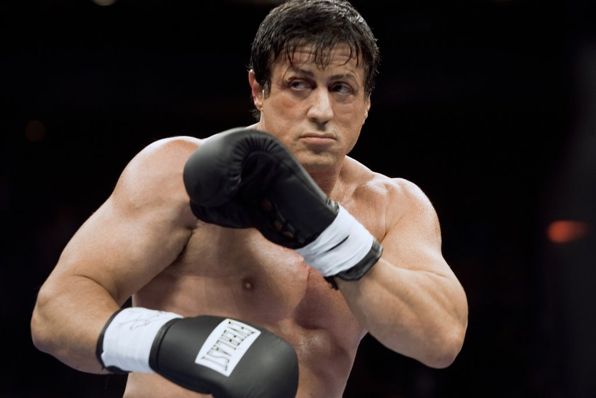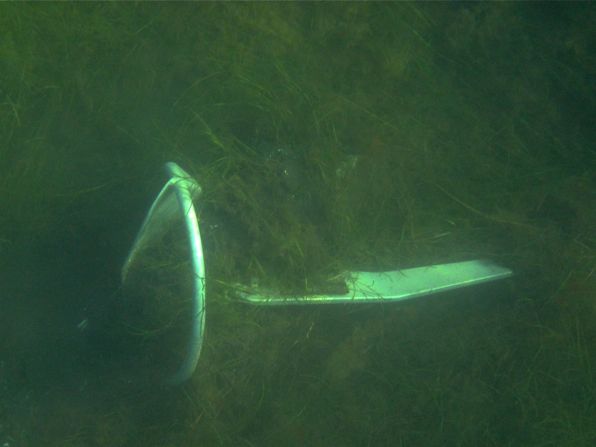Thanks Rocky!
It was pretty windy here last night, and although we were tied to a dock instead of anchored out, this is as good a time as any to say “thanks Rocky.”
No, not this Rocky…

I was referring instead to our Rocna anchor, which we have nicknamed Rocky. Since we started using Rocky last year it (he) has set perfectly on the first try every time. Although we haven’t yet had to deal with winds over 30 knots while at anchor, we have had to deal with multiple 180? wind shifts and have done so without issue.
Below is a pic of the Rocna we snapped at Navy Bay earlier in the week.

Photo taken in about 8′ of water with our underwater Canon camera.
It doesn’t look to me like it is buried all that well but it held when I set it under considerable reverse engine power.
For those who are curious, yes we have nicknamed our other anchor too. He goes by Lil’ Bruce (a 10kg chrome Bruce anchor) and he rides on our port side bow roller. Our 10kg Fortress anchor remains untested, and unnamed.
I wonder what kind of anchor this ship uses, and equally as importantly, I wonder if they named their anchor(s) too!

We saw this ship raising her sails just outside Kingston this week.
I think it is the Brigantine St. Lawrence II.
By the way, for those who missed it, we added the TRX exercise video to yesterday’s post a bit later in the day. Check it out.


The wind shifts (and countercurrents) are what get ya. So it looks like Rocky is earning his keep.
I don’t know what it’s like in other places but 180 degrees wind shifts around here are super common!
Of course, we don’t have tidal currents to deal with, which would do much the same thing I guess.
Not exactly – you will learn this where you are going.
When they oppose and the wind is light, you can get the rope pulled one way, the boat pointing the other, and the rope around the keel or rudders.
Your heavy bridle plate will help, by taking the rode down when the tide is reversing. That is when you are most vulnerable. Chain helps too. Anchoring in shallower water helps.
Once I was anchored inside a barrier island and heard an odd sound. Water running. I checked our position; rock solid. I checked the knot meter; 4.5 knots, without moving! If the wind had been strong I would have had an interesting ride; which one would win?
Yes, I’ll guess we’ll have to learn!!!
Might I suggest that your third anchor is female and that you call her Tressy.
😀
Wonderful idea Sandra. Because you suggested it, Tressy it is. 🙂
FWIW,
Our experience with “Rocky” (BTW, we named ours this FIRST, you guys can be the sequel, Rocky II) has been to NOT use a lot of throttle (if any) to set it. This may depend somewhat on the bottom type and the amount of chain v. rope rode. To date, we have only used chain and find on sandy/muddy bottoms that the wind pushes the boat back with enough force to easily set this anchor.
Again, FWIW…
Fair Winds,
Mike
I read this RIGHT AFTER we backed down on our anchor. 🙂
I usually set my anchor by using the wind, as well. Why start the motor when you don’t have to! 🙂
We actually don’t stop the engines until we back down on it. They idle while we clean up the sails and let the anchor settle. Then we back down on it.
A couple of weeks ago we anchored and the wind was very light, but I knew it was going to pick up later in the evening. We were drifting in a weird direction so I didn’t want the anchor to set on that line. We actually used the engines to turn the boat to back down on the line I knew the wind would be coming from. That is one example where I think the engines, if not required, certainly are helpful to get a good set.
This title and following line seems very familiar. lol see post here
http://www.sailblogs.com/member/joeynchristine/?xjMsgID=122128
That’s funny. I remember reading that post. Both Rebecca and I were very envious, reading about how you have access to such great courses.
well now we are the ones to be jealous. You have approx 40 days I believe til takeoff? While we have just pushed ours back until next Spring.
Don’t be jealous. Delaying our departure from 2009 to 2010 was the best thing we could have done. The chance of us dying has now been GREATLY reduced. 🙂